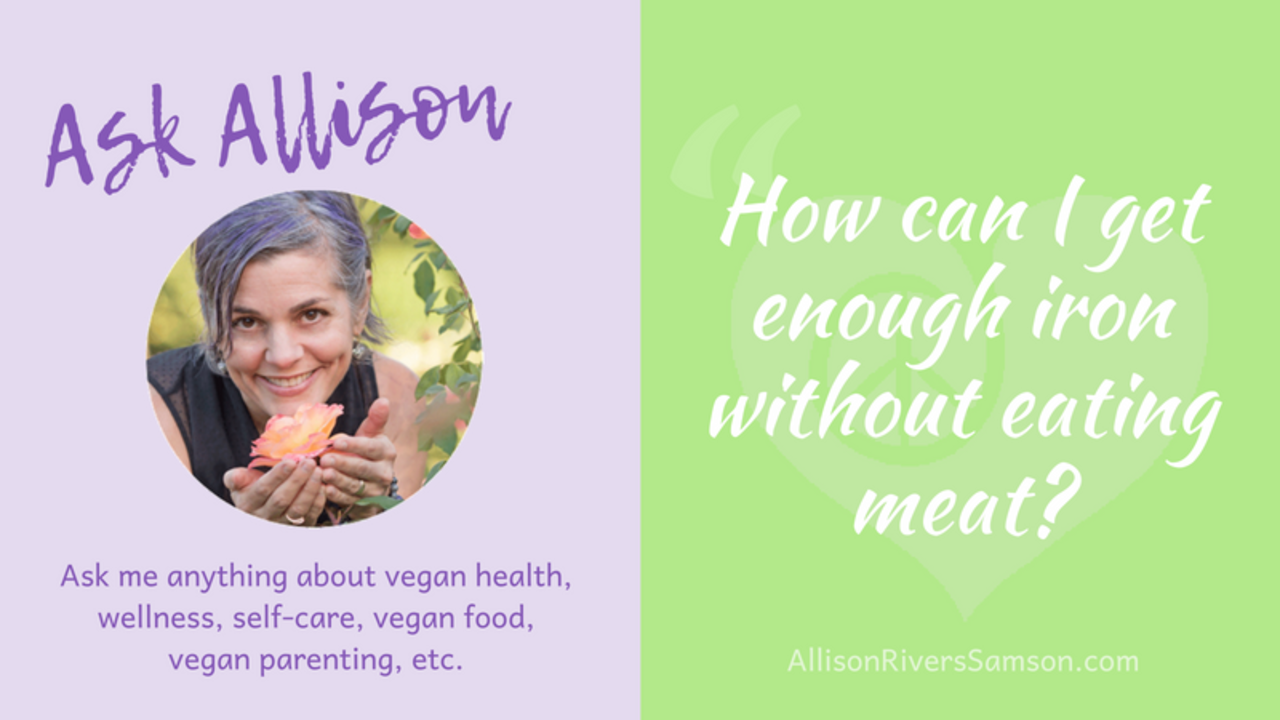
Ask Allison: How can I make sure I’m getting enough iron without eating meat?
Today, I’m introducing a new series, Ask Allison, where you can ask me anything about health, wellness, self-care, vegan recipes, vegan parenting, etc.
The first question comes from Alice, who asks:
"I’ve been vegetarian for a while now and was recently told that I’m borderline anemic. What are good vegan sources for iron?"
This is a question I hear often and have even experienced myself in my early days of being vegetarian.
As a holistic wellness coach, I help people make subtle (and sometimes not so subtle) shifts in their lives so they’ll feel better and live healthier in body, mind, and spirit.
Some of the top vegan sources of iron include cooked lentils 6mg/cup, cooked spinach 6.4mg/cup (see important note below about citrus and greens), pumpkin seeds 4.2mg/oz, and cooked quinoa 2.8mg/cup.
When it comes to the nitty-gritty of nutrition, I turn to the expert doctors and dietitians who live and breathe the science. They give the guidelines that I then help my clients implement. So the docs give the recommendations, and I help you figure out how to fit them into your life in a sustainable way.
What is iron’s role in the body?
According to University of California San Francisco Health:
Iron is found in red blood cells as hemoglobin and in muscle cells as myoglobin. Hemoglobin transfers oxygen in the blood from the lungs to the tissues. Myoglobin accepts, stores, transports, and releases oxygen.
About 6% of the body’s iron is a part of certain proteins, essential for breathing and metabolism, as well as a component of enzymes that produce collagen in the skin and some neurotransmitters in the brain. Iron is essential for proper immune function.
So, iron plays an important role in giving us energy, strength, stamina, and immunity. No wonder it’s so important to make sure our levels are on track!
A while back, I had the honor of interviewing Brenda Davis, R.D., who is a longtime vegan and brilliant dietitian and researcher. Co-author of nine books, including Defeating Diabetes and Becoming Vegan: Express Edition (there’s also a comprehensive version with over 600 pages for professionals and science lovers).
I asked Brenda about iron: I commonly get questions about iron intake. What are a few vegan sources (and combinations) that you’d recommend?
Brenda Davis, R.D.: Many people will be surprised to learn that there is no greater risk for iron deficiency anemia among vegans than among the general population. Vegans actually consume more iron than omnivores. However, vegans do not consume the most bioavailable form of iron called heme iron. Heme iron is the iron in blood so comes only from animal flesh products. We are just beginning to understand that non-heme iron (found in plants and animal products) gives us an advantage over heme iron, keeping us on safe ground between too little and too much iron. Plant sources of iron are ideal, as the body has some control over absorption efficiency and can adjust uptake to suit our need. If our iron reserves are low, we absorb more iron from plant foods; if abundant, our intestines block the absorption of this non-heme iron. Pregnant women can absorb over 60 percent more iron than they did before pregnancy. Heme-iron often acts as a pro-oxidant, potentially increasing disease risk.
I also asked Brenda: Is it true that squeezing lemon juice onto greens makes the iron bioavailable because the vitamin C unlocks the iron?
Brenda Davis, R.D.: Yes, any foods rich in vitamin C or organic acids such as citric acid increase the absorption of iron. (they change the form of iron so it is soluble and more absorbable).
Another excellent source of information is the inimitable Dr. Michael Greger, author of How Not to Die. If you don’t yet have this book, I highly recommend that you get it. Dr Greger also provides the invaluable resource NutritionFacts.org, a strictly non-commercial, science-based public service of free updates on the latest in nutrition research via bite-sized videos. On the subject of iron, there are 30+ videos! On his site, you can subscribe and get his daily videos.
It’s important to note that when we use the lens of the Standard American Diet as a point of comparison when looking at blood levels, a vegan’s blood is going to look very different.
To the untrained doctor or dietitian who typically works with omnivores, concerns may be raised where it’s unnecessary and some things may be missed. This is why it’s helpful to work with someone who understands how to read the blood tests of vegans and vegetarians so that the data can be interpreted in a useful way. If you’d like references for this, I can help.
Send me your question for my next Ask Allison!
With vibrant love,


